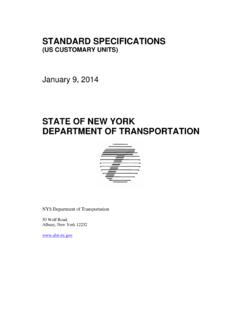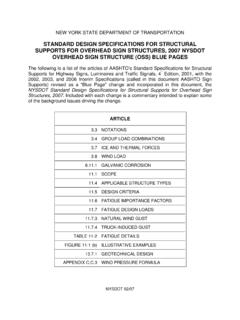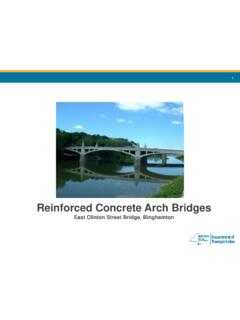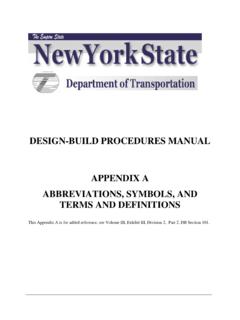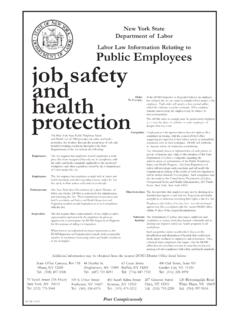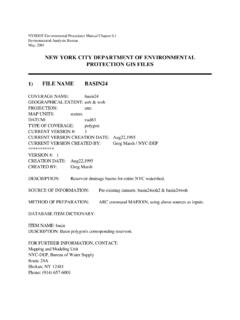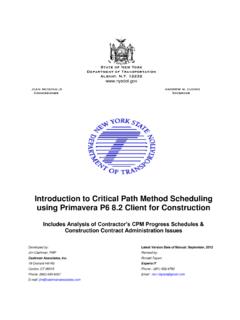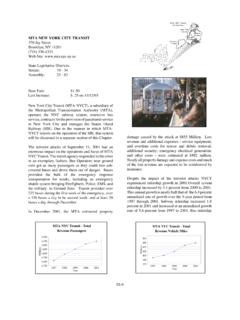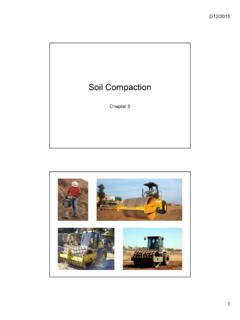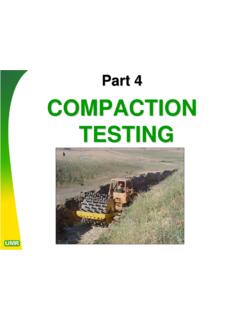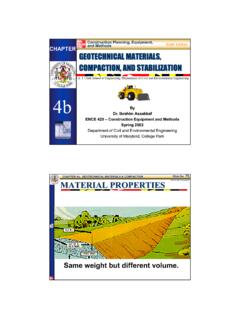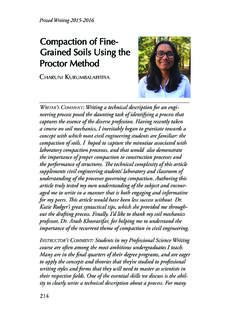Transcription of TEST METHOD FOR EARTHWORK COMPACTION CONTROL …
1 TEST METHOD FOR EARTHWORK COMPACTION CONTROL BY NUCLEAR GAUGE GEOTECHNICAL TEST METHOD GTM-10 Revision #5 AUGUST 2015 EB 15-025 Page 1 of 11 GEOTECHNICAL TEST METHOD : TEST METHOD FOR EARTHWORK COMPACTION CONTROL BY NUCLEAR GAUGE GTM-10 Revision #5 STATE OF NEW YORK DEPARTMENT OF TRANSPORTATION GEOTECHNICAL ENGINEERING BUREAU AUGUST 2015 EB 15-025 Page 2 of 11 TABLE OF CONTENTS 1. SCOPE ..3 2. SUMMARY OF METHOD ..3 3. LICENSING AND CERTIFICATION ..3 Licensing ..3 Certification ..3 4. TEST PROCEDURE ..4 Preparation Prior to Testing ..4 Test Location Data ..5 Testing and Sampling ..5 5. DATA AND CALCULATIONS ..6 Determination of Plus in.
2 (19 mm) Material and Moisture Content ..7 CONTROL Density ..8 APPENDIX ..11 A. Equipment .. A-1 B. Illustration Showing Where Material for One Point proctor Test is Obtained - Figure B-1 C. Density Correction Curves Plus in. (19 mm) Material Specific Gravity ..C-1 D. Moisture Nomograph - Moisture Relationship between Total Sample and Minus in. (19 mm) Material .. D-1 E. COMPACTION CONTROL Curves - Family 1 and Family 2 .. E-1 F. Field COMPACTION Data Sheet - Nuclear Direct Transmission - Form SM 418b . F-1 EB 15-025 Page 3 of 11 1. SCOPE This test METHOD describes the procedure for determining the in-place density and moisture of EARTHWORK through the use of a nuclear gauge.
3 The density of the material shall be determined by direct transmission and the moisture content shall be determined by backscatter. This METHOD may be used in conjunction with either the Standard or Modified proctor Density Test for determining the percent of Maximum Density. The details included in this test METHOD are for use with the Standard proctor Test. 2. SUMMARY OF METHOD The test consists of the following steps which are explained in the test procedure: - Determining the Wet Density - Determining the Moisture Content - Calculating the Dry Density - Determining the Maximum Density - Calculating the percent of Maximum Density 3. LICENSING AND CERTIFICATION Licensing New York State requires that the owner of a nuclear gauge be licensed by the State Health Department.
4 The license requires that the operator of the device be certified and that the device be maintained and stored in a safe manner. Certification Operator's certification is acquired by successfully completing training in the theory and use of a nuclear gauge. This training and certification is usually conducted by the manufacturer under the auspices of the State Health Department. EB 15-025 Page 4 of 11 4. TEST PROCEDURE Preparation Prior to Testing: When using this test METHOD for COMPACTION CONTROL , it is important that the test be performed immediately after the material has been placed and compacted. Refer to the manufacturer's operator's manual to determine any restrictions for the use of the gauge in confined areas or other limiting factors.
5 In the event that the gauge cannot be used, the methods described in "Test METHOD for EARTHWORK COMPACTION CONTROL by Sand Cone or Volumeter Apparatus," or any other METHOD approved by the Department shall apply. Warm-up and check the equipment. A. Daily Most nuclear gauges require a warm-up period and standard count determination prior to test operations. The daily standard counts shall be within the limits specified by the manufacturer. Refer to the manufacturer's operator's manual for details. B. Monthly or Periodic When in use, the manufacturer's initial standardization shall be checked at least once every thirty (30) calendar days to assure proper equipment operation.
6 When not in use, this gauge calibration shall be checked periodically as recommended by the manufacturer. This field calibration shall be within the appropriate limits set forth by the manufacturer. Refer to the manufacturer's operator's manual for the specific METHOD of performing these checks. A log book shall be prepared and accompany each gauge. The log will indicate the gauge serial number, the daily standard counts and the monthly or periodic standard calibration counts. The gauge shall not be used if the readings fall outside the specified limits set forth by the manufacturer's manual. The log should include the dates used, the locations of its use and the name(s) of the operator(s).
7 Remove all loose and disturbed material at the test site. Prepare a flat surface large enough to accommodate the gauge such that the bottom of the gauge is in intimate contact with the test surface. Surface depressions should not exceed in. (3 mm). Use native fines to fill any larger depressions. It may be necessary to sieve native material through a No. 10 (2 mm) sieve to obtain sufficient fines. Using the drill rod and drill rod guide, form a hole at least 2 in. (50 mm) deeper than the maximum test depth. For lift thicknesses that are equal to or less than the probe length, the probe should be placed at the bottom of the compacted lift. Compacted EB 15-025 Page 5 of 11 lift thicknesses that exceed the probe length may require excavation and additional tests to evaluate the full thickness of the lift.
8 Note that the additional testing may result in a confined area situation. Refer to Section Placing one foot on the drill rod guide will prevent disturbance while driving the drill rod. It will be easier to position the gauge if a light line is scribed in the ground around the outside edge of the drill rod guide. Care should be taken to prevent disturbance of the material surrounding the hole while removing the drill rod. Test Location Data Form SM 418b is used for recording COMPACTION test data. Refer to this form in Appendix F. Form SM 418b uses US Customary Units (lbs.) for recording the larger weights (test sample & tare, tare, Plus in.)
9 (19 mm) Material, etc.). Before starting the test, enter all the information required at the top of Form SM 418b, such as: Project, Contract No., Region, County, PIN, Test By and Gauge Ser. No. A specific gravity of (Plus in. (19 mm) material) shall be assumed unless otherwise directed by the Regional Geotechnical Engineer. 1. Date of Test 2. Test No. - tests for a project shall be numbered as required by MURK. 3. Station of Test - The location of test should be determined accurately. 4. Offset - The location of test should be determined accurately. 5. Location - The required percent of maximum density for the material depends on its location. Indicate whether the test is performed in the embankment, in the subgrade area, at a structure location or at another area with specific COMPACTION requirements.
10 6. Soil Type - Briefly describe the material tested so that the appropriate Family of COMPACTION CONTROL Curves is used. Testing and Sampling Place the gauge on the prepared area and insert the probe into the performed hole to the desired depth. Seat the gauge. A properly seated gauge sits firmly on the ground with the probe in firm contact with the side of the probe hole nearest the detectors. Run three complete one minute tests at each site. Reseat the gauge, as described in , after each test. From these three tests , for gauges other than direct reading gauges; record, on Form SM 418b lines D and F, the lowest density count and the highest moisture content.
